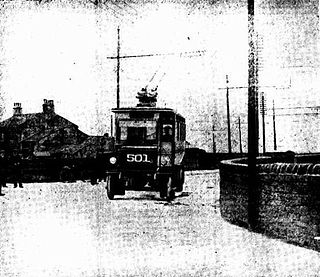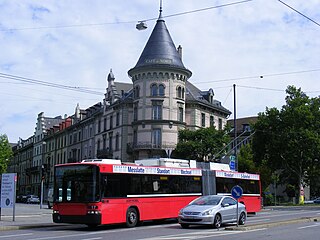
A trolleybus is an electric bus that draws power from dual overhead wires using spring-loaded trolley poles. Two wires, and two trolley poles, are required to complete the electrical circuit. This differs from a tram or streetcar, which normally uses the track as the return path, needing only one wire and one pole. They are also distinct from other kinds of electric buses, which usually rely on batteries. Power is most commonly supplied as 600-volt direct current, but there are exceptions.

The Boston-area trolleybussystem forms part of the public transportation network serving Greater Boston in the U.S. state of Massachusetts. It opened on April 11, 1936, and since 1964 has been operated by the Massachusetts Bay Transportation Authority (MBTA). It currently includes two physically isolated networks: one serving the towns of Cambridge, Belmont, and Watertown, the other – the Silver Line (Waterfront) – located in the city of Boston proper. Prior to 1964, several additional trolleybus lines were in operation in Boston proper. Measured by fleet size, the system was the third-largest trolleybus system in the United States at its peak, with only the Chicago and Atlanta systems having more trolleybuses than Boston's 463.

The Chesterfield and District Tramways Company and its successors ran a tramway system in the Derbyshire town of Chesterfield, England. The first horse-drawn line opened in 1882, and in 1897, the system was taken over by Chesterfield Corporation, who extended and electrified it in 1904 and 1905. Additional tramcars were purchased, but two had to be scrapped after a disastrous fire at the depot in 1916. The system suffered from a lack of maintenance as a result of reduced staffing levels during the First World War, and the trams were replaced by trolleybuses in 1927.
The Mexborough and Swinton Traction Company was the name adopted by the Mexborough & Swinton Tramways Company in 1929 following the introduction of trolleybuses on all its routes. It operated in the West Riding of Yorkshire, England, over routes serving Manvers Main Colliery, Wath upon Dearne and the towns of Rotherham, Rawmarsh, Swinton, Mexborough, Conisbrough and the estate at Conanby.

Ilkeston Corporation Tramways was a tramway network in Ilkeston, Derbyshire, in the East Midlands of England run firstly by Ilkeston Borough Council and from 1916 by the Nottinghamshire and Derbyshire Tramways Company. The system ran between 1903 and 1931. Ilkeston was the first town in Derbyshire to adopt and operate a fully electrical tramway system.

Trolleybuses in Wellington were part of the Wellington public transport system from 1924 until 1932 and again from 1949 until 2017. It was the last trolleybus system operating commercially in Oceania and the last major system operating in a country where driving is on the left side of the road.

The Leeds trolleybus system served the West Riding of Yorkshire city of Leeds in England between 1911 and 1928. In May 2016, plans to construct a new system, the New Generation Transport (NGT) project, were refused approval from the UK Department for Transport, following a negative report from the planning inquiry.

Trolleybuses served the London Passenger Transport Area from 1931 until 1962. For much of its existence, the London system was the largest in the world. It peaked at 68 routes, with a maximum fleet of 1,811 trolleybuses.

The Nottingham trolleybus system once served the city of Nottingham, in the county of Nottinghamshire, England. Opened on 10 April 1927, it gradually replaced the Nottingham tramway network.
The Southend-on-Sea trolleybus system once served the town of Southend-on-Sea, in Essex, England. Opened on 16 October 1925, it gradually replaced Southend-on-Sea Corporation Tramways.

The Philadelphia trolleybus system, or trackless trolley system as it is known by its operator, forms part of the public transportation network serving Philadelphia, in the state of Pennsylvania, United States. It opened on October 14, 1923, and is now the second-longest-lived trolleybus system in the world. One of only five such systems currently operating in the U.S., it presently comprises three lines, and is operated by the Southeastern Pennsylvania Transportation Authority (SEPTA), with a fleet of 38 trolleybuses. The three surviving routes serve North and Northeast Philadelphia and connect with SEPTA's Market–Frankford rapid transit line.

The Bern trolleybus system is part of the public transport network of Bern, the capital city of Switzerland. Opened in 1940, it combines with the Bern S-Bahn, the Bern tramway network and Bern's urban motorbus network to form an integrated all-four style scheme.

The Zürich trolleybus system is part of the public transport network of Zürich, Switzerland. Opened in 1939, it combines with the Zürich S-Bahn, the Zürich tramway network and Zürich's urban motorbus network to form an integrated all-four style scheme.
The Pretoria trolleybus system was part of the public transport network in Pretoria, South Africa, for more than 30 years in the mid-twentieth century.

Cape Town, South Africa, has had two tramway networks forming part of its public transport arrangements. Both networks are now long closed.
Aberdare Urban District Council Tramways operated a tramway service in Aberdare between 1913 and 1935. It was the only system in the United Kingdom which consisted of a tramway with feeder services run by trolleybuses from the start. The trolleybuses used the Austrian Cedes-Stoll system, and became increasingly difficult to maintain. Parts of the trolleybus network were converted to tramways in the early 1920s, and the rest stopped operating in 1925, when no trolleybuses were available for service. The tramway continued for another ten years, but was closed in 1934 and 1935 as a result of a downturn in the prosperity of Aberdare, due to collieries closing and the population dwindling. Motor buses took over the local services once the tramway had closed.
Keighley Tramways Company operated a tramway service in Keighley between 1889 and 1901 with horse power. The system re-opened three days later as Keighley Corporation Tramways and stayed in service until 1924 when it closed for good.

The Oldham trolleybus system once served the town of Oldham, then in Lancashire, but now in Greater Manchester, England.













